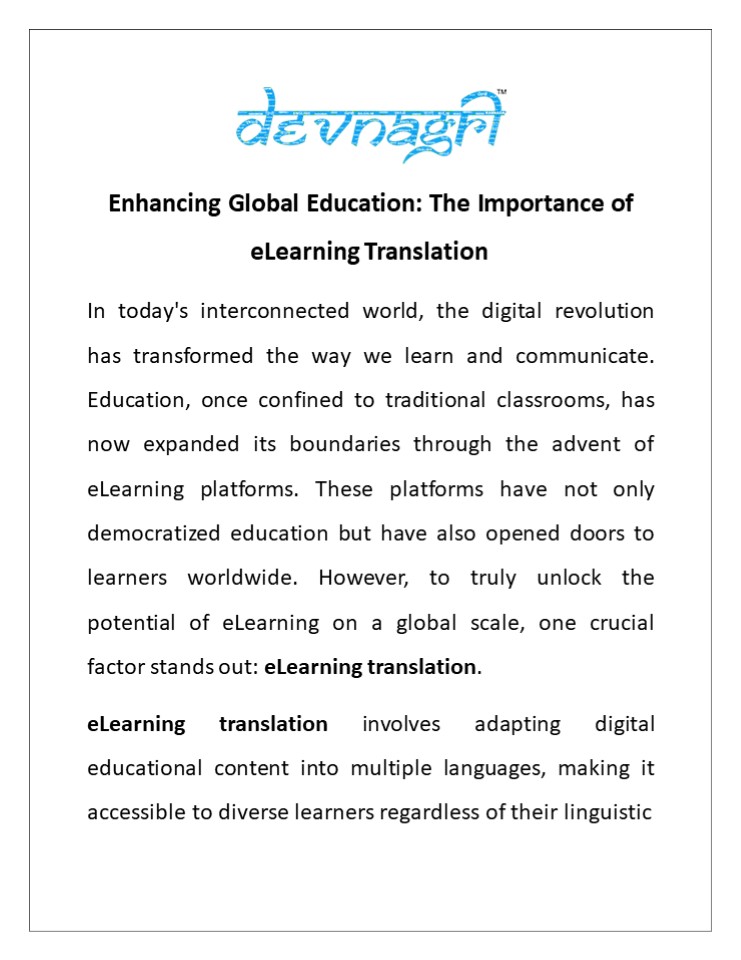Enhancing Global Education: The Importance of eLearning Translation - PowerPoint PPT Presentation
Title:
Enhancing Global Education: The Importance of eLearning Translation
Description:
eLearning translation is not merely a matter of linguistic conversion; it is a catalyst for global education transformation. By breaking down linguistic barriers, expanding reach, and ensuring cultural relevance, eLearning translation paves the way for inclusive and equitable learning experiences. Visit Here - – PowerPoint PPT presentation
Number of Views:1
Title: Enhancing Global Education: The Importance of eLearning Translation
1
Enhancing Global Education The Importance of
eLearning Translation In today's interconnected
world, the digital revolution has transformed
the way we learn and communicate. Education,
once confined to traditional classrooms, has now
expanded its boundaries through the advent of
eLearning platforms. These platforms have not
only democratized education but have also opened
doors to learners worldwide. However, to truly
unlock the potential of eLearning on a global
scale, one crucial factor stands out eLearning
translation. eLearning translation involves
adapting digital educational content into
multiple languages, making it accessible to
diverse learners regardless of their linguistic
2
backgrounds. This process goes beyond mere
linguistic conversion it encompasses cultural
nuances, educational standards, and
technological considerations to deliver a
seamless learning experience. Here's why
eLearning translation is paramount in today's
educational landscape Bridging Linguistic
Barriers Language serves as a significant barrier
to education for millions of people worldwide.
By translating eLearning materials into various
languages, barriers to learning are dismantled,
allowing individuals from different linguistic
backgrounds to access educational content
effortlessly. This inclusivity is vital in
promoting equal opportunities for education and
empowering learners globally. Expanding Reach
and Impact
3
The global reach of eLearning platforms is
unparalleled.
However, without translation, their impact
limited to English-speaking audiences.
remains Through
translation, these platforms can extend their
reach to non-English-speaking regions, catering
to the needs of learners from diverse cultural
and linguistic backgrounds. This expansion not
only increases the platform's user base but also
enhances its societal impact by disseminating
knowledge to underserved communities
worldwide. Cultural Relevance and
Sensitivity Effective learning goes beyond
language it encompasses cultural context and
sensitivity. Translating eLearning content
involves more than just linguistic conversion it
requires understanding cultural nuances and
tailoring content to resonate with diverse
audiences. By incorporating cultural relevance
into translated
4
materials, eLearning platforms
can enhance learner
engagement and comprehension, fostering a deeper
connection between the content and the
learners. Compliance with Educational
Standards Education systems vary across regions,
each with its own set of standards and
requirements. eLearning translation involves
ensuring that translated content aligns with
these educational standards, maintaining
consistency and quality across different
language versions. This adherence to standards
ensures that learners receive educationally
sound content regardless of the language in
which it is presented, upholding the integrity of
the learning experience. Leveraging
Technological Advances Advancements in
technology have streamlined the eLearning
translation process, making it more efficient
5
and cost-effective. Machine translation, coupled
with human expertise, enables rapid translation
of large volumes of content while ensuring
accuracy and quality. Additionally, technologies
such as artificial intelligence and natural
language processing facilitate adaptive learning
experiences, tailoring content to individual
learner preferences and language proficiency
levels.
Addressing the Skills Gap In today's global econo
my, skills
proficiency is a
prerequisite for success. eLearning platforms
play a crucial role in addressing the skills gap
by providing accessible and flexible learning
opportunities. Through translation, these
platforms can reach learners in regions where
skill shortages are prevalent, equipping them
with the knowledge and skills needed to thrive
in their respective industries. By bridging the
skills gap through
6
eLearning translation, societies can growth and
prosperity on a global scale.
foster
economic
Conclusion eLearning translation is not merely a
matter of linguistic
conversion it transformation.
is a catalyst for global education
By breaking down linguistic barriers,
expanding reach, and ensuring cultural relevance,
eLearning translation paves the way for
inclusive and equitable learning experiences. As
technology continues to evolve, the potential
for eLearning translation to revolutionize
education on a global scale is boundless. By
embracing this transformative practice, we can
unlock the full potential of digital education
and empower learners worldwide.































